Journalists are eligible for free email subscriptions to SEJournal, including TipSheet, WatchDog (on access issues) and more.
Multimedia
conference coverage
| Agenda | Coverage | Lodging/Travel | Advertise/Exhibit | Environmental News | About Chattanooga |
SEJ's 23rd annual conference, October 2-6, 2013, was hosted by the University of Tennessee at Chattanooga and the Chattanooga Times Free Press. Below, you'll find multimedia coverage provided by SEJ, volunteers and conference attendees, posted as it arrives.
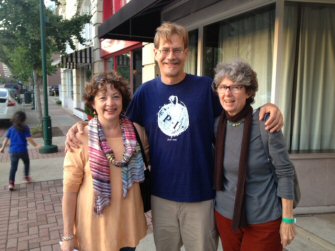 |
|
Conference co-chairs Pam Sohn (left) and Anne Paine with SEJ's conference director Jay Letto. |
For other coverage, see also:
- SEJ's Facebook page
- SEJ's Facebook discussion group
- Storify, for Twitter and Facebook posts by attendees using #SEJ2013
- SEJ's photos on Flickr
- Public SEJ Chattanooga 2013 Flickr conference photo group, where you can upload/share your own conference photos
If you attended the conference, please take a few minutes to tell us how we did. What you think matters to us and your feedback helps SEJ make future conferences more valuable. Click here to take our online conference evaluation.
Thank you to all our volunteer writers, recorders and photographers — you are invaluable!
It's critically important to SEJ to gather evidence on the impact of our work. Please help us to keep SEJ strong and share links, photos, copies of reporting generated or informed by this conference! Thanks!!! Send your story links to Cindy MacDonald, SEJ's Web content manager.
Page Menu
Wednesday, October 2
Thursday, October 3
Friday, October 4
Saturday, October 5
Sunday, October 6
Miscellaneous conference coverage
Wednesday, October 2
All-Day Workshop: Successful Freelancing 201
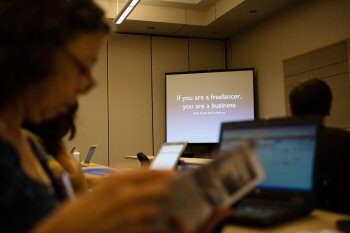 |
|
Photo © Roberto [Bear] Guerra. |
One incredible benefit of your SEJ membership is the annual conference, where journalists come together to discuss best practices and experts gather to share knowledge. And for those who can’t make it to the conference, we offer audio of the workshops for free.
Each year the conference also sponsors additional workshops for smaller groups. People attending these workshops pay extra fees for the opportunity to have an intensive learning experience on a particular topic.
This year's all-day Wednesday workshop focused on the business of freelancing. For the first time, we are making audio from this workshop available to those who did not attend. If you are interested in this audio, you can download the files below. But if you find it useful, we ask that you provide a suggested donation of $15 to the SEJ endowment: Donate now.
- Show Me the Money audio file (MP3/01:19:03).
- Business Strategy for the Long Haul audio file (MP3/01:29:23).
- The Art of the Pitch 201 audio file, Part One (MP3/00:18:58).
- The Art of the Pitch 201 audio file, Part Two (MP3/00:46:03).
- Freelance Ethics audio file (MP3/01:29:20).
- Workshop description.
From Chattanooga to Chennai: Reporting on Population and Sustainability in an Urbanizing World
- "How to Tell the Biggest Stories of Our Times," Inter Press Service, October 5, 2013, by Kanya D'Almeida.
- Session description.
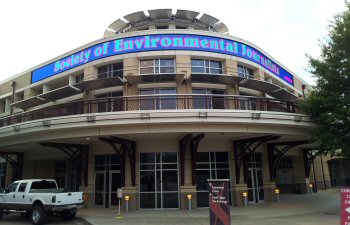 |
|
SEJ's name in lights on the Chattanooga Convention Center. |
Opening Reception
- "Video: How the 'dirtiest' city in America became the Chattanooga we love today," Chattanooga Times Free Press, October 7, 2013 (a Chamber of Commerce video, 10 min/9 seconds, shown during the Wednesday evening festivities).
- Session description.
Thursday, October 3
Tour 1: Old King Coal: Cradle to Grave
- "Everything That Had Been Alive Was Buried," Matter, March 19, 2014, by Rachel Cernansky.
- "Prize Staff Reflections from the 23rd Annual SEJ Conference," Goldman Environmental Prize blog, October 10, 2013, by Goldman Staff.
- Tour description.
Tour 3: Chattanooga: From Gritty City to Green-Manufacturing Hub
- "The Chattanooga Way – How a city comes together to make a difference," Take HeART blog, October 15, 2013, by Hilary Sloane.
- See tour photos by Charlotte Kidd here.
- Tour description.
Tour 4: Biodiversity 1: From the Mountain Tops to the River Bottoms
- "The Pleasures — and Ecological Benefits — of River Snorkeling," Pacific Standard, June 14, 2016, by Mary Catherine O'Connor.
- "Depth of Understanding: A Firsthand Lesson in Conservation," Get Out, Chattanooga Times Free Press, November 2013, by Sunny Montgomery.
- "Can freshwater snorkeling promote preservation?" Great Lakes Echo, October 8, 2013, by David Poulson.
- Tour description.
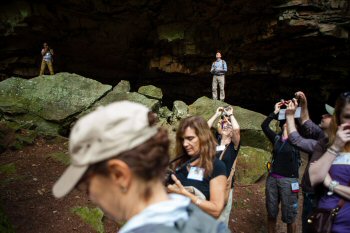 |
|
Photo © Roberto [Bear] Guerra. |
Tour 6: Biodiversity 2: Threats and Opportunities on the Species-Rich Cumberland Plateau
- "Naturalist Trevor Goward Helps to Overturn a 150-Year-Old Truth of Science," Scientific American, June 2017, by Erica Gies.
- "Tennessee's fragile Cumberland Plateau ecosystem threatened by human interaction, scientists say," NOLA.com | The Times-Picayune, October 8, 2013, by Mark Schleifstein.
- "Hemlock Extinction Looms over Tennessee Forests," Extinction Countdown blog, Scientific American, October 11, 2013, by John R. Platt.
- Tour description.
 |
|
Photo © Christi Turner. |
Tour 7: Fracking, Tennessee Style
- Video of speaker Anne Davis, Managing Attorney, Nashville Office, Southern Environmental Law Center.
- "Texas and Tennessee Are Pretty Fracking Different," Water Tells blog, October 11, 2013, by Lana Straub.
- Tour description.
Tour 8: The New Civil War: The Struggle to Preserve History
- "Some Ceremonies This Fall Commemorate Trail of Tears," National Native News, October 25, 2013, by Chuck Quirmbach. This audio story (MP3/00:01:16) is about the October 26, 2013, Trail of Tears event in Chattanooga, using audio gathered during SEJ's New Civil War tour.
- "As Wisconsin Honors Civil War Veterans, Battle Site Preservation Issues Remain," Wisconsin Public Radio, November 22, 2013, by Chuck Quirmbach. About half the audio for this story (MP3/00:03:29) was gathered during SEJ's New Civil War tour.
- Tour description.
Tour 9: How Sustainable Ag Feeds Sustainable Cities
- "The travails of a sustainable farmer," The Guardian, October 8, 2013, by Marc Gunther.
- Tour description.
VW's E-Golf and XL1 Plug-in Hybrid Debut
SEJ's Chattanooga conference hosted the U.S. debut of the 261-mpg Volkswagen XL1 Plug-in Hybrid. The XL1 was on display Thursday evening through Saturday afternoon. A variety of other cars were available for attendees to "ride-and-drive."
- "Volkswagen debuts incredible new 261-mpg hybrid in Chattanooga," Mother Nature Network, October 4, 2013, by Jim Motavalli .
- "Driving VW's E-Golf (and Debuting the Amazing XL1 in the U.S.)," PluginCars.com, October 7, 2013, by Jim Motavalli .
An Evening with Aldo
- "Aldo Leopold, Portrayed on Stage", Wisconsin Public Radio, November 30, 2013, by Chuck Quirmbach. Audio (MP3/00:01:38).
- Session description.
Friday, October 4
Electrifying Cars: The Next Five Years
- Audio file (MP3/01:01:20).
- "The future on two wheels (or maybe three)," Mother Nature Network, October 14, 2013, by Jim Motavalli.
- "Six Ways Electric Vehicles Are Stimulating the Economy," Today's Engineer Online, October 2013, by John R. Platt.
- Session description.
Opening Plenary — Just What Is a Sustainable City?
- Audio file (MP3/01:20:46).
- Session description.
Concurrent Session 1: THE CRAFT 2: Sound Storytelling: Using Audio to Cover Science and the Environment
By Morgan Smith
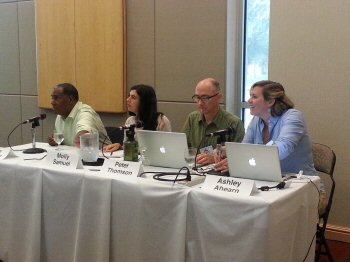 |
|
L-R: Steve Curwood, Molly Samuel, Peter Thomson and moderator Ashley Ahearn. © Photo by Morgan Smith. |
In the session Sound Storytelling: Using Audio to Cover Science and the Environment, you’ll listen to sound bites from several interviews and enjoy a lively discussion about the importance of storytelling. According to the panel, you should tell a story like you are talking to a friend, be someone listeners feel like they can trust, and be a performer. The last one is just as significant as the first two because showing emotion through your voice makes a piece a lot more interesting. The importance of sound, namely ambient noise, is stressed by most of the panel, along with some important tips on reporting and piecing together your projects. When producing a radio segment, you want to use your best "stuff" and have a good lead. The lead is crucial and, during the discussion, Ashley Ahearn admits that the lead is the first thing she writes. The best part about a panel like this is that everyone brings their expertise. When a reporter sets out to get a story, it is vital to have a magic moment of sound and know what you want the audience to get from your story, and if there’s the chance that your subject may get emotional, remember Steve Curwood’s words, "You will only get them to cry once."
- Audio file (MP3/01:30:54).
- "The 'Texas miracle' is fueling huge economic growth — and the climate change that may end it," PRI's The World in partnership with The Texas Tribune, December 3, 2014, by Neena Satija. (Yes, the date is correct. This three-part series is the result of PRI's The World environment editor Peter Thomson meeting Texas Tribune's Neena Satija at this "Sound Storytelling" session 15 months ago. That's how valuable SEJ's annual conference is for networking!!)
- Session description.
Concurrent Session 1: THE CLIMATE: Climate Change and Media Coverage: Have We Blown It?
- Audio file (MP3/01:19:53).
- Session description.
Concurrent Session 1: THE WATER: The Many Faces of Dam Removal
By Helen Spain
Brad Tyer, Steven Hawley and Gerrit Jöbsis discussed dam removal and its impact on the environment. Some of the impacts that dams have on streams and waterways include cutting off migratory fish’s paths, lack of sediment transport downstream, and industrial waste getting trapped above the dams, causing sickness downstream. Fishermen are usually the ones to suggest taking the dams out, and the community generally backs them up with this request. Many dams are ready to come down, but the biggest holdup for any dam removal project is funding. Currently, there are people looking for ways to reduce the costs for removing dams.
- Audio file (MP3/01:23:27).
- Session description.
Concurrent Session 1: THE NATION: Nukes, Fossil Fuels, Alternatives: What Will Power Our Future?
- Audio file (MP3/01:19:23).
- "South’s New Power Push: Natural Gas and Tiny Nukes," Climate Central, October 8, 2013, by Bobby Magill.
- Session description.
Concurrent Session 1: THE GLOBE: Shifting From a Toxic Legacy to a Sustainable Future
- Audio file (MP3/01:15:36).
- Session description.
Concurrent Session 2: THE CRAFT 1: Environmental Reporting With Drones: What's the Future?
- Audio file (MP3/01:18:26).
- Session description.
Concurrent Session 2: THE CRAFT 2: Social, Mobile & Local — A Workshop on New Tools for Environmental Reporting
- Audio file (MP3/01:16:04).
- Session description.
Concurrent Session 2: THE LAND: Endangered Species Success Stories: Reintroduction, Restoration and Protection
By Morgan Smith
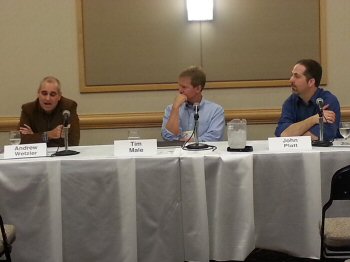 |
|
L-R: Andrew Wetzler, Tim Male and moderator John Platt. |
In this panel, John Platt, Tim Male, and Andrew Wetzler discussed endangered species like Grizzly Bears, Black Footed Ferrets, California Condors and a few other species. According to Wetzler, “98% of the species under the Endangered Species Act are still alive today.” Male and Wetzler contemplate the definition of success and agree that success for a certain species is when it no longer needs the government’s help. There is also the difficult question of when is it time to take the species off the endangered list. This is a tricky situation because you can never tell how many will be enough. When Platt asks, “Are there limits to what we can do?” Wetzler replies, “There may be a limit to our willingness, but not our ability.” As Male states, sometimes different countries have different laws, like with the case of the Bison in Mexico. The people in North Mexico believe Bison should be protected; however, if they cross the border into Mexico they are treated as livestock. Currently, New Zealand is the best at conservation, but all it takes is cooperation and the willingness to do what needs to be done. The most important U.S. Endangered Species success story is that of the bald eagle. Once on the verge of extinction, the bald eagle species has been removed from the endangered list because they can take care of themselves now.
Concurrent Session 2: THE CLIMATE: All Impacts Are Local: Bringing Climate Change Close to Home
- Audio file (MP3/01:14:02).
- Session description.
Concurrent Session 2: THE CITY: Biomimicry and Biophilic Cities: What Can Nature Teach Us About Sustainability?
- Audio file (MP3/01:12:34).
- Session description.
Concurrent Session 2: THE WATER: Flooding, Drought and Water Wars
By Helen Spain
Rena Stricker, Paul Davis, and Steve Fleischli were speakers on this panel moderated by Ben Hall. They discussed water wars, drought and flooding, and their importance to agriculture and cities. The speakers mainly focused on the southeast with their discussions, and referenced the flood in Nashville in May 2010 for how we could be using our budgets for preventative measures to flooding. Another suggestion made was to retain water during a flood in cisterns, and then when there is a drought to use this water to irrigate fields that need it. As for water wars, the main tensions tend to be between upstream and downstream users, because people downstream need the water just as much as people upstream.
- Audio file (MP3/01:20:37).
- Session description.
Concurrent Session 2: THE NATION: Who's Your Energy Daddy? From Rural Cooperatives to Energy Giants
- Audio file (MP3/01:12:51).
- Session description.
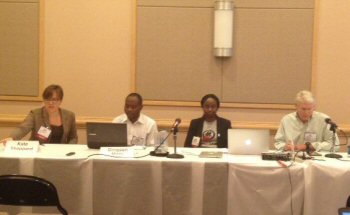 |
|
L-R: Kate Sheppard, Dingaan Mithi, Gladys Kalema-Zikusoka and moderator Ken Weiss. © Photo by Christina Stafford. |
Concurrent Session 2: THE GLOBE: More Than Numbers: Population, Environment and Human Rights
- Audio file (MP3/01:14:43).
- Session description.
Saturday, October 5
Game On! Breakfast, Environmental Games and Journalism
- Audio file (MP3/00:59:07).
- Download a list of some new environmental games (PDF).
- Session description.
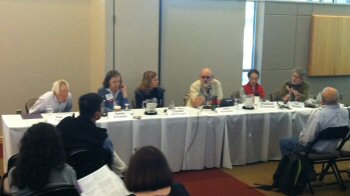 |
|
L-R: Rae Tyson, Karen Schaefer, Camilla Mortensen, John Messeder, Elizabeth Grossman and moderator Tim Wheeler. |
Concurrent Session 3: THE CRAFT 1: Obstacles to Access: Strategies for the Stonewalled
- Audio file (MP3/01:21:25).
- Session description.
Concurrent Session 3: THE CRAFT 2: Can Nonprofit News Orgs Save Environmental Journalism?
- Audio file (MP3/01:22:59).
- Video conversation (00:01:40) with Roberto (Bear) Guerra, Freelance Photographer, and Caroline D'Angelo, Social Media Editor of Pulitzer Center on Crisis Reporting, October 5, 2013, by Lana Straub.
- "U.S. Science Reporters Becoming an Endangered Species," Inter Press Service, October 15, 2013, by Zofeen Ebrahim.
- Session description.
Concurrent Session 3: THE LAND: Wild Cities
- Audio file (MP3/01:22:59).
- Session description.
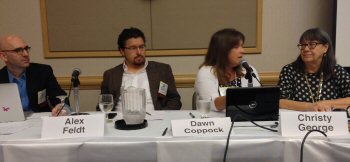 |
|
L-R: Joseph Romm, Alex Feldt, Dawn Coppock and moderator Christy George. © Photo by Adam Stephens. |
Concurrent Session 3: THE CLIMATE: What Would Jesus/Plato/Confucius Do... About CO2?
- Audio file (MP3/01:08:31).
- "Experts Debate Moral, Religious Case for Climate Action," Climate Central, October 9, 2013, by Bobby Magill.
- Session description.
Concurrent Session 3: THE CITY: What Makes Green Buildings Really Green?
- Audio file (MP3/01:26:59).
- Session description.
Concurrent Session 3: THE WATER: Combined Sewer Overflows: The Gift That Keeps on Polluting
- Audio file (MP3/01:21:21).
- Session description.
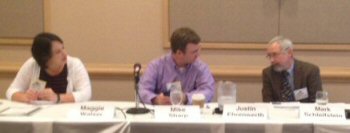 |
|
L-R: Maggie Walser, Mike Sharp and moderator Mark Schleifstein. © Photo by Christina Stafford. |
Concurrent Session 3: THE GLOBE: The BP Deepwater Horizon Disaster’s Silver Lining
- Audio file (MP3/01:15:31).
- Session description.
Concurrent Session 4: THE CRAFT 1: Follow the Frackin' Money
- Audio file (MP3/01:15:47).
- Download a resources list of past news stories focused on fracking and finance (PDF).
- Session description.
Concurrent Session 4: THE CLIMATE: Climate & Weather: Is Juiced Up Severe Weather Already the New Normal?
- Audio file (MP3/01:11:06).
- "Local Governments Planning for Climate Change, Looking for More Specific Predictions," Wisconsin Public Radio, October 7, 2013, by Chuck Quirmbach.
- Session description.
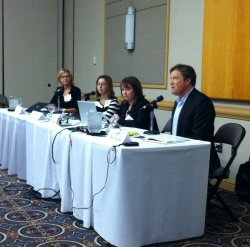 |
|
Moderator Jeffrey Burnside and panelists. |
Concurrent Session 4: THE CITY: Corporate Green: Sustainability Success Stories from the Business World
- Audio file (MP3/01:25:42).
- Session description.
Concurrent Session 4: THE WATER: Sleuthing Dam, Impoundment, and Levee Databases
- Audio file (MP3/01:14:06).
- "Bigfoot, dams and environmental newsworthiness," Great Lakes Echo, October 7, 2013, by Eric Freedman.
- Data Resources for Dams, Impoundments, and Levees, compiled by session presenter Joseph A. Davis.
- Session description.
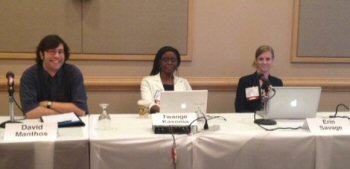 |
|
L-R: Panelists David Manthos, Twange Kasoma and Erin Savage. |
Concurrent Session 4: THE GLOBE: Citizen Science: Empowering Awareness from Appalachia to Africa and Above
- Audio file (MP3/01:10:38).
- Session description.
Lunch and Plenary Session — Is Diversity (Bio and Otherwise) the Backbone of Sustainability?
- Audio file (MP3/01:00:37).
- Session description.
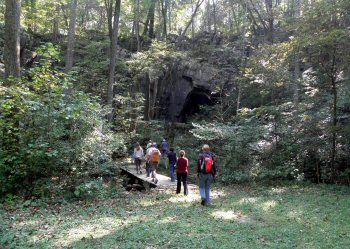 |
|
Conference attendees approach Frick's Cave, where white nose syndrome was recently found in 'bachelor' bat cave. Photo © Karen Schaefer. |
Mini-Tour 1: Frick's Cave, Bats, and White Nose Syndrome
- Location changed to Frick's Cave near Chickamauga, GA due to government shutdown
More than 35 SEJ journalists met with Tennessee Tech and Alabama A&M scientists Brian Carver and Wes Stone to learn more about the spread of white nose syndrome to bats of the Southeastern U.S. Ron Miller, chairman of the Southeastern Cave Conservancy, and cave caretaker E. T. Davis talked about their efforts to prevent human spread of the disease. Carver and Stone are both hopeful that warmer southern temperatures and shorter winters will prevent the high mortality rates seen in the Northeast. But the disease has only emerged in the Southeastern region within the last few years, so scientists and caving groups are watching developments closely. By tour co-leader Karen Schaefer. - Video by SEJ member John Messeder (00:47:47). This video is copyrighted. All rights reserved. For special permission to use any portions of the video, contact John directly: john@JohnMesseder.com
- Background and speaker contact information.
- Tour description.
Sunday, October 6
How's the Future Look... for Your Environment Book?
- Audio file (MP3/01:27:10).
- Session description.
Miscellaneous conference coverage:
"Society of Environmental Journalists conference generated buzz on what Chattanooga's doing right," Chattanooga Times Free Press, October 27, 2013, by Pam Sohn.
"Mini Miracles in Chattanooga, Tennessee," Bohemian Adventures blog, October 20, 2013, by Wendee Nicole.
"What Chattanooga Needs: A Green Airport Link," Car Talk, October 7, 2013, by Jim Motavalli.
Video of Stephanie Tsao test-driving the Nissan Leaf by Lana Straub.
"Insights on Hybrid Vehicles, Making Global Warming Local," The Yale Forum on Climate Change & The Media, October 10, 2013, by Christine Woodside.
"EJ or not EJ? Commitment and the freelance life," Covering the Planet blog, Knight Center for Environmental Journalism at Michigan State University, October 9, 2013, by Eric Freedman.
"VW’s X1 concept car hits 62 miles on one liter of gas," TG Daily, October 8, 2013, by Beth Buczynski.
"Bigfoot, dams and environmental newsworthiness," Great Lakes Echo, October 7, 2013, by Eric Freedman.
"Going to a new conference? When in doubt, volunteer," SciLance website, October 7, 2013, by Sarah Webb. "I spoke at the freelance workshop on Wednesday, facilitated a lunch about urban forestry on Friday, and co-led a bicycle mini-tour around town on Saturday."
"SEJ Conference and New Blog Post," October 7, 2013, by Emily Guerin. Including "one of the most thought-provoking discussions on biodiversity I’ve heard in a long time."
Video: SEJ Members say why they love SEJ, October 5, 2013, by Lana Straub.
"The view from Chattanooga," Covering the Planet blog, Knight Center for Environmental Journalism at Michigan State University, October 5, 2013, by Eric Freedman.
"Journalist Calls Fukushima a Cultural Disaster," The Allegheny Front, October 5, 2013, by Jennifer Szweda Jordan. [Editor's Note: Sam Eaton was a speaker in SEJ's Wednesday, October 2, 2013, session "Visualizing Demographic Change: Using Maps, Graphics, and Video," part of the "From Chattanooga to Chennai: Reporting on Population and Sustainability in an Urbanizing World" workshop.]
Video conference coverage on LiveStream, by Lana Straub.
"Environmentalists Note Chattanooga's Sustainable Efforts," WTVC News Channel 9, October 4, 2013, by Briona Arradondo.
"Environmental journalist group event goes on in Chattanooga despite gridlock," Chattanooga Times Free Press , October 3, 2013, by Louie Brogdon.
"Volkswagen XL1, World's Most Fuel-Efficient and Aerodynamic Production Car, Makes U.S. Debut in Chattanooga: XL1 Displayed at the 2013 Society of Environmental Journalists Conference," Marketwired, October 3, 2013.







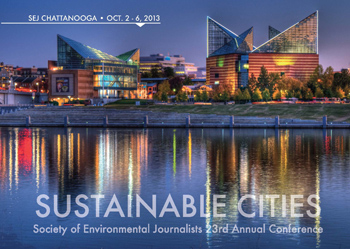





 Advertisement
Advertisement 



